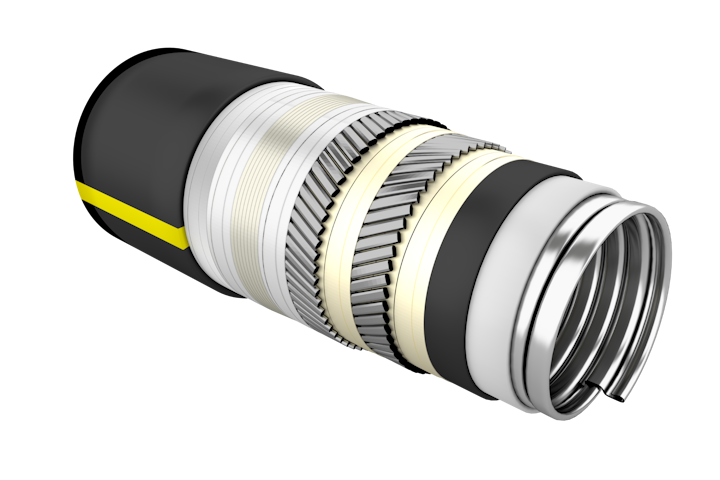New flexible pipe technology designed for challenging environments
Published on by Water Network Research, Official research team of The Water Network in Business
Baker Hughes has developed new designs for flexible pipe, moving from purely metallic strength to a carbon fiber composite pressure armor layer, marking a major step-change in the industry.

The hybrid composite flexible pipe reduces overall system complexity.
(Courtesy Baker Hughes)
Features carbon fiber composite pressure armor layer
Ray Burke , Baker Hughes
The first flexible pipes were used in the offshore oil and gas industry in 1972. These early models were built and applied as a ‘kill and choke’ line and formed with a bonded type of material, usually vulcanized rubber and armoring.
Since then, the demands for this technology have steadily grown and diversified. Today, they are found in every major production basin worldwide and are used for everything from risers, flowlines, fluid transfer lines and jumpers, all designed to keep production flowing efficiently.
The development of flexible pipe technology has accelerated in recent years. Of course, the clear trend across the oil and gas industry has been operators looking for operational efficiencies wherever possible. Marginal gains in operational efficiency have become the order of the day.
However, implementing this is trickier than it may sound given that many new fields are in some of the most challenging environments the industry has ever had to contend with. Deeper water, higher temperatures, higher pressure, aging infrastructure, and complex chemistry all stack up to create ever more intense conditions for flexible pipe to withstand. In short, more and more fields are pushing the boundaries of existing technology. So, is it feasible to expect even more from flexible pipe technology?
Why go flexible?
Every project, at some point, must make a choice between rigid or flexible pipeline. The simplicity of the rigid carbon steel, welded together on a barge or at a spoolbase and then laid on the seabed, has been overshadowed in some cases by the more sophisticated mechanism of a flexible pipe. Installation and operation are simplified by design, before the pipes are constructed and shipped.
The choice of subsea pipeline technology is often based on local conditions, technical requirements, installation vessel availability, operator preferences, and cost efficiency.
The ability to apply flexible pipe in the most challenging environments is a significant part of its appeal. High performance in water depths beyond 2,500 m (8,202 ft), high pressure reaching beyond 10,000 psi, and high temperatures more than 130°C (266°F), as well as the ability to withstand large vessel motions in adverse weather conditions, point toward why flexible pipelines have increased in popularity in recent times.
For floating production, flexible risers are often the only option that solves the geometric constraints of water depth, fluid pressure, vessel motions due to environmental loading, and the consequential fatigue degradation of steel.
Of course, these operating conditions are set against their own challenging backdrop. Even five years after the downturn hit, almost every operator continues to encourage supplier-led solutions to reduce cost and standardize and simplify subsea system installation and operation.
Media
Taxonomy
- Utility Pipe Network
- Pipeline
- M S Pipeline Construction
- Piping Design, Stress analysis
- Pipes and Pipelines